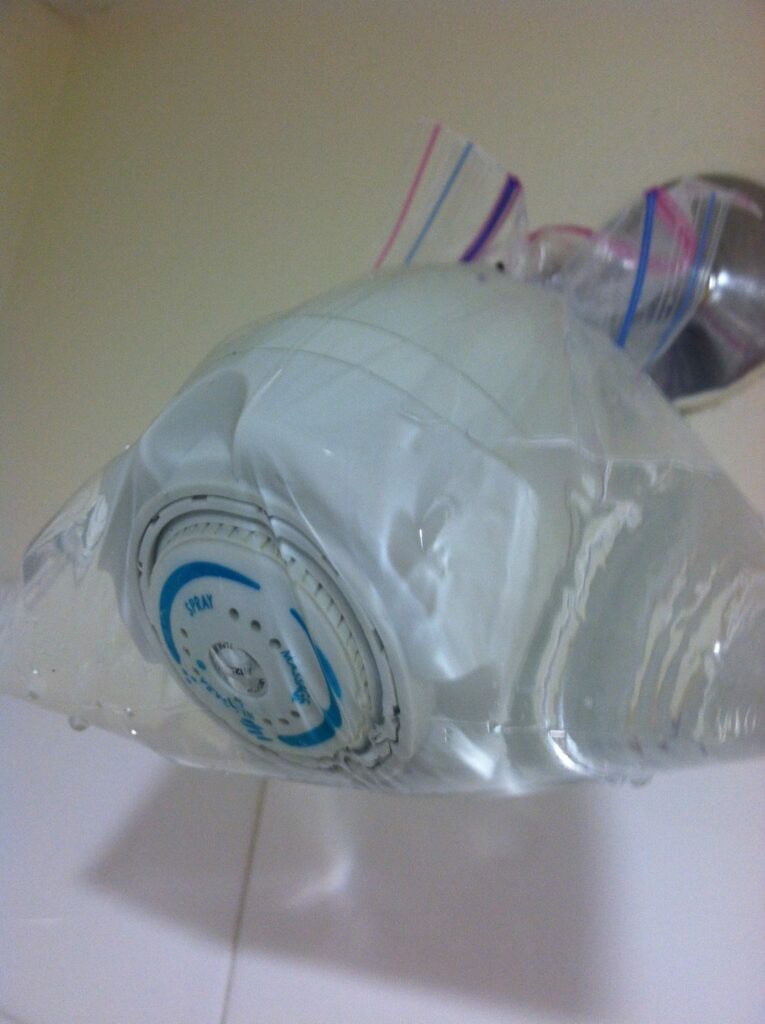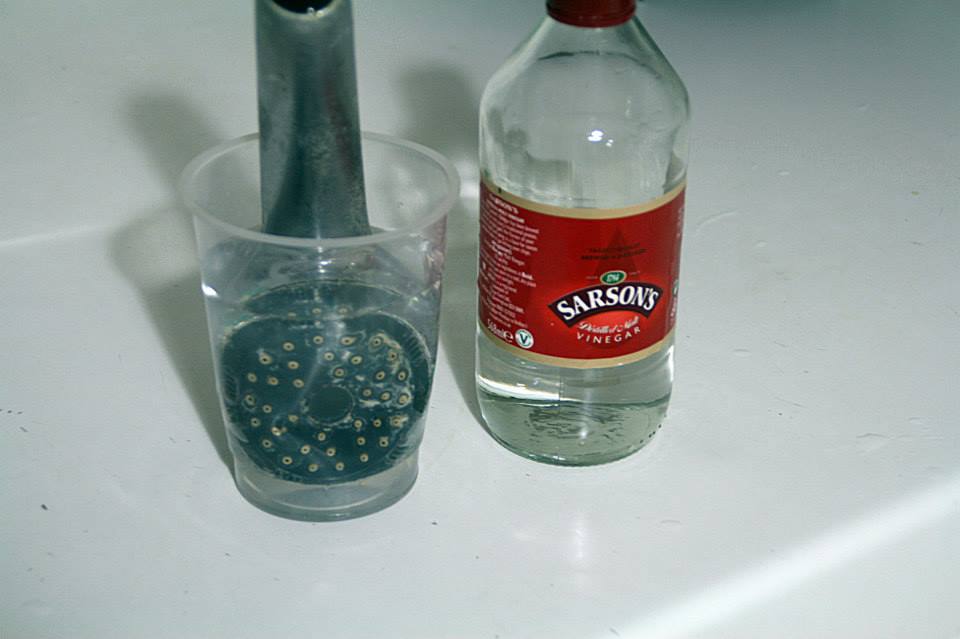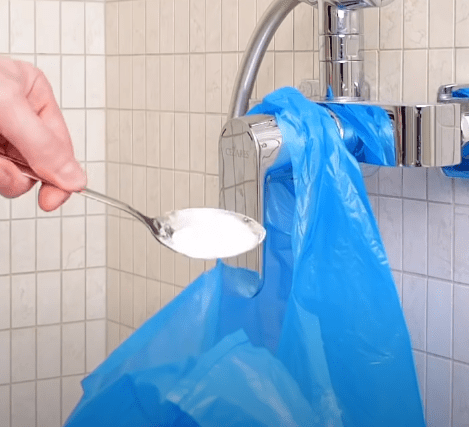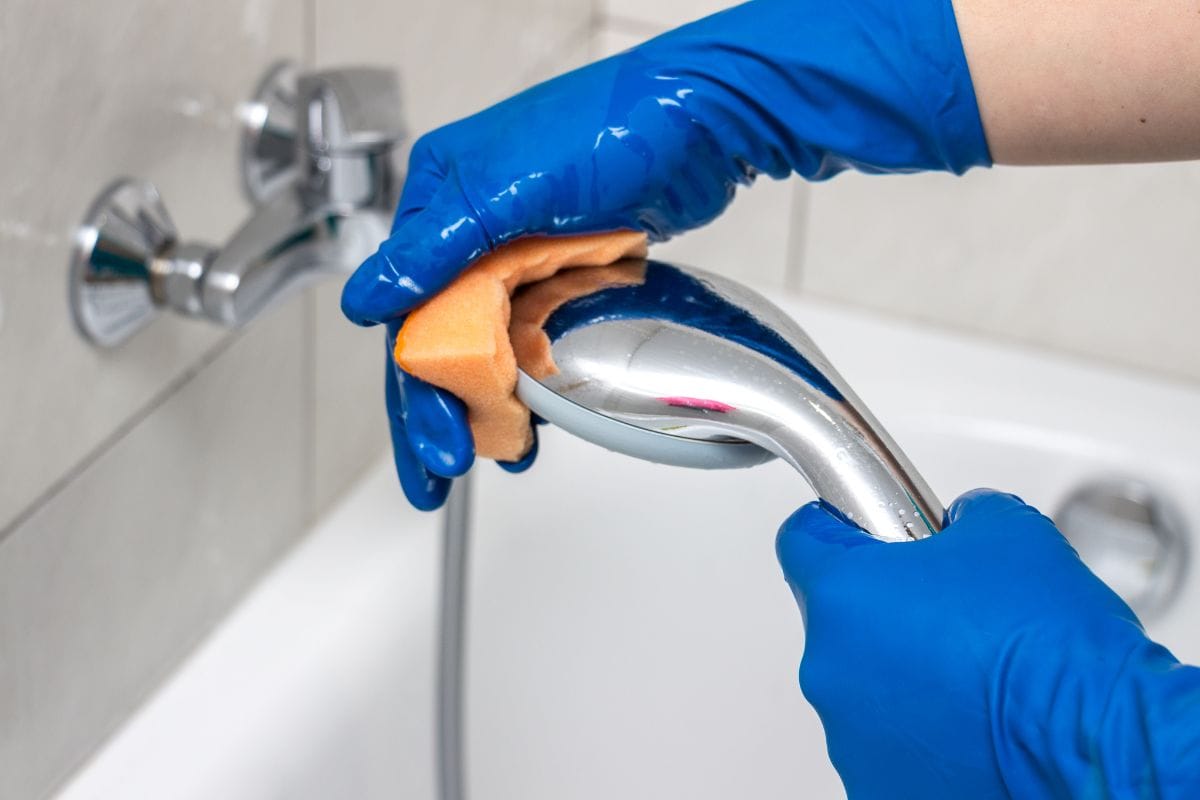One of the most underrated household responsibilities is cleaning your shower head. It’s such an overlooked cleaning habit that most forget to do it altogether. But what happens if we leave it for too long?
Leaving your shower head uncleaned can lead to a build-up of limescale, bacteria, mould, or even toxins. So, regular cleaning isn’t just a case of hygiene but health as well. But don’t worry; it’s easier than you might think!
How to Clean a Shower Head
As with anything in life, there are different ways to approach cleaning your shower head. Which method you use depends on your personal needs and preferences.
You can clean your shower head by unscrewing and removing it or without removing it. Most people choose to clean it without removing it at first. Then, when it needs a deeper clean, they unscrew it to remove that stubborn build-up. Let’s look at how these two methods differ.
Clean a Shower Head Without Removing It

Sometimes your shower head needs a clean, but you’re not in the mood to make the effort of removing it. But there is a way to clean it while keeping it in its place.
Clean your shower head without removing it by doing the following:
- pour white vinegar into a plastic bag,
- submerge the head into the vinegar,
- fasten the bag with a rubber band,
- and leave it for 30-60 minutes.
The white vinegar contains acids that help remove white and green mineral deposits, like limescale. The longer you leave the shower head in it, the more effective it will be. So, you can consider leaving it on overnight for better results.
Of course, there are other things you can use instead of vinegar, but we’ll get into that a bit later on.
Clean a Shower Head by Removing It

While cleaning it without removing it is effective, it doesn’t always target the parts with bacterial or scale build-up. So, it might be necessary to disassemble the shower head to get into those tiny pesky spaces.
To clean your showerhead by removing it, do the following:
- Unscrew and disconnect the shower head: Use a wrench to unscrew it and ensure you cushion it with a towel to avoid damage to the different parts.
- Rinse it under the faucet: Get rid of the superficial deposits by holding the shower head upside down under a running tap.
- Clean additional deposits: If stubborn deposits are stubborn, use a toothpick to unclog the nossles and a toothbrush to scrub them off. Be gentle, though: you don’t want to scratch the surface.
- Soak parts in vinegar for an hour or overnight: Leaving the different pieces in vinegar will remove excess scale.
- Reassemble the shower head: Once you’re satisfied with the cleanliness, you can reassemble the shower head and enjoy fresh, clean showers!
How to Remove Limescale from a Shower Head

Limescale is that white chalky deposit on your shower head, faucets, and toilet bowl once the water evaporates. The longer you leave it, the more difficult it is to clean.
Get rid of limescale by regularly wiping the shower head with vinegar or store-bought limescale remover. It would also help if you deep clean it every once in a while to get the best results.
The trick is not to allow it to get too bad before intervening. But, if you do, it’s not the end of the world. With some TLC, it will be as good as new in no time.
What Causes Limescale on Your Shower Head?
The water that runs through your taps isn’t pure H2O. Because it comes from a water source and goes through a treatment plant, it undergoes chemical disinfection to eliminate viruses, bacteria, or harmful toxins.
Limescale is caused by the build-up of calcium found in your tap water. The more your water runs, the more calcium residue builds up and leaves distinctive white marks.
So, while it’s not harmful, it can dry out your skin and leave your hair feeling dull and dry with excess exposure.
How to Prevent Limescale on Your Shower Head?
While you can’t eliminate the calcium in your tap water, there are ways you can prevent limescale build-up. It might take a few extra minutes a day and adapting your weekly cleaning schedule. But making an effort will leave your shower head spotless.
Prevent limescale build-up by drying the shower head after showering and cleaning it weekly. If you don’t allow water to sit on the head and evaporate, you prevent the calcium residue from forming.
Other Shower Head Cleaning Methods
The most common advice to clean a shower head is to use white vinegar. But there are other substances you can use instead. It includes store-bought cleaners and different pantry staples you might already have in your home. Those include:
- Baking powder
- Dish soap
- Commercial cleaners
- Lemon juice
- Coca-cola
- Oven cleaner
- Salt
You can use some of these by themselves to clean the shower head, but you’ll have to combine others for the best cleaning results.
Baking Powder, Vinegar, and Dish Soap

How dirty is your shower head? Does it only have limescale? Or does it have green, brown, or black spots as well? If that’s the case, you might need more than just vinegar to clean it properly.
To give your shower head a deep clean like no other, combine two parts vinegar, one part baking soda, and two tablespoons of dish soap in your plastic bag. You’ll notice bubbles forming as the vinegar and baking soda interacts.
Then, tie your bag around the shower head to submerge it under the mixture and let sit for 30-60 minutes. This combination of ingredients will help combat limescale, mould, dirt, grime, and other toxins that might be trapped in your shower head.
Commercial Cleaners

Suppose you’re not in the mood to dabble in mixing various pantry staples to clean your shower head. In that case, you might consider a commercial cleaner. Most supermarkets will have a shower cleaner or descaling agent you can buy.
Commercial cleaners are chemically formulated acid-based liquids that combat stubborn shower scale, dirt, or mould. But, while they are effective, they can be toxic to humans. So, you’ll have to take extra precautions when you use these substances.
These precautions include:
- Wear gloves to prevent your hands from getting chemical burns
- Wear a face mask to avoid inhaling the strong fumes
- Work in a well-ventilated room to prevent the fumes from accumulating
- Wear protective glasses to avoid getting the cleaner in your eyes
Not all commercial cleaners are the same, so their instructions might vary. So, if you decide to use them, read the instructions carefully before cleaning your shower head with them.
Lemon Juice
Like vinegar, lemon juice is a natural and safe option for cleaning your shower head. It contains citric acid, which helps to eliminate limescale, bacteria, mould, and germs.
And you’ll use it the same way you would have used vinegar:
- by pouring it into a bag and tying it around the shower head or
- unscrewing the shower head and letting the different parts bathe in a tub of lemon juice.
Again, the longer you allow the parts to contact the lemon juice, the more effective they will be. So, anything between 30 minutes and a few hours will do the trick.
Keep in mind that the juice might leave your shower head feeling sticky. So wipe it off with water after the juice bath and dry it off completely.
Coca Cola
You might not have considered this beverage a cleaning agent, but it will help clean your shower head if you have it in your home. That’s because coca cola has small amounts of phosphoric acid, eliminating the grime, scale, and mould.
Although you can use it as a cleaner, it might not be as effective as some of the other methods. But, if you have nothing else to clean your shower head with, this will suffice.
The best way to use coca-cola as a cleaner is:
- Fill a large enough bowl with your coca-cola,
- Unscrew the shower head, and
- Let it sit in the liquid for 20-30 minutes
- If it still has scale or mould, you can let it sit in a fresh batch of coca-cola for another 20-30 minutes.
- Once you’re satisfied with the result, wipe the parts to get rid of the stickiness
- Reassemble your shower head.
Oven Cleaner
If you don’t want to disconnect your shower head but want to get rid of the grime or grease, your oven cleaner will do the trick.
Oven cleaner is an excellent way to eliminate the grime in the nozzles or other tiny spaces on your shower head. That’s because it is specially formulated to combat stubborn grease in your oven while cooking.
Be careful, though, because oven cleaner is an abrasive agent. It might damage your skin and your shower head’s shiny finish. So, to avoid this, wear protective gloves and don’t let them sit on your shower head for too long. Spray it on, let it sit for a few minutes, and then wipe it off completely.
Combining Lemon Juice and Salt to Combat Rust
In some cases, you might have a more significant issue at hand than mould, grime, scale, or bacteria. Your shower head might start to rust. Although it’s not hazardous to your health, it might cause skin irritation or cause damage to your hair in the long run.
Combat a rusty shower head with a mixture of lemon juice and salt. The acid in the lemon juice will loosen the rust from the shower head while the salt helps to absorb it. It helps eliminate minor rust spots and prevent them from getting out of hand.
Here’s how you use lemon juice and salt to combat rust in your shower head:
- Pour lemon juice over the rust spots to get them wet.
- Sprinkle salt over the damp rust areas (the salt will act as an abrasive).
- Gently scrub the area with a microfibre cloth.
- Wipe the area with a wet towel and dry off completely.
- If there is still some rust, repeat the process until it all vanishes.
While this method is excellent for combating mild rust, it won’t help if the rust is severe. In that case, you might consider commercial rust removal or a new shower head altogether.
How Often Should You Clean Your Shower Head?
Cleaning your shower head regularly will help maintain your bathroom hygiene and prevent excess build-up of scale, bacteria, or toxins.
Clean your shower head once a week by wiping it with vinegar or your cleaning agent of choice. This is not a deep cleaning process but a superficial one instead. The more frequently you clean your shower head superficially, the less you’ll have to deep-clean it in the future.
How Often Should You Descale Your Shower Head?
When you shower, water sits on your shower head, dries off, and the calcium deposits remain on the head. So, while regular cleaning will help eliminate these deposits, you’ll need deep cleaning and descaling now and again.
Deep clean and descale your shower head once a month. Do this with the bag over the shower head method or removing the shower head and bathing it in a solution of your choice. This way, you target the finer areas, like the nozzles, that are difficult to clean with your regular cleaning routine.
The Takeaway
Every shower head needs cleaning to prevent a build-up of scale, bacteria, mould, toxins, and germs. The easiest way to do that is to have a regular cleaning and deep cleaning schedule. The more you clean your shower head, the less likely this problematic build-up will persist.
Every person has their preferred cleaning agents, so choose the one you’re most comfortable with. It could be a store-bought agent or a natural option like vinegar or lemon juice. You’ll never have a grimy shower head again if you clean it weekly and descale it monthly.

Amos Christen graduated with a bachelor’s degree in Interior Design from Drexel University — Philadelphia, PA. Since 2003, Amos has worked with top interior design professionals in this area, including architects and interior/graphic/lighting designers. As a skilled interior designer, Amos Christen is highly versed in fine arts and crafts and uses that to supplement his main area of expertise. He often publishes articles related to home décor on several websites, including Sprucetoilets.com, Sprucebathroom.com, and Mybesuitedhome.com. He also contributes to leading interior design magazines.
